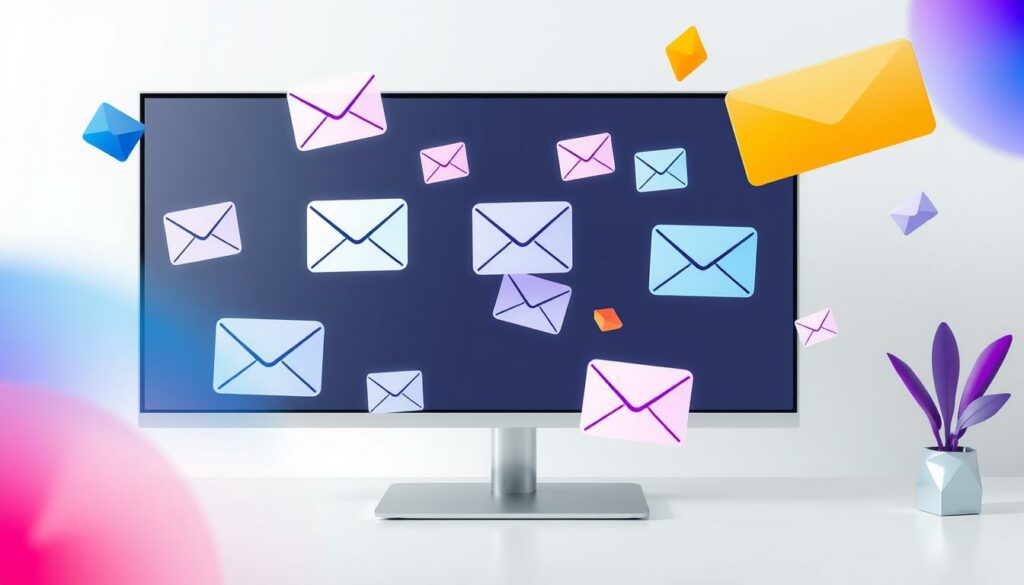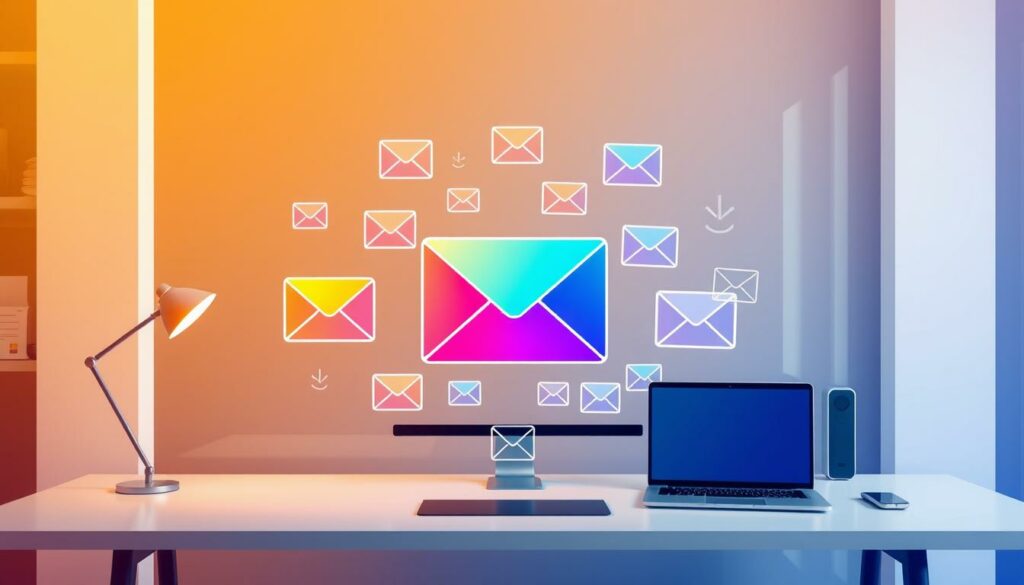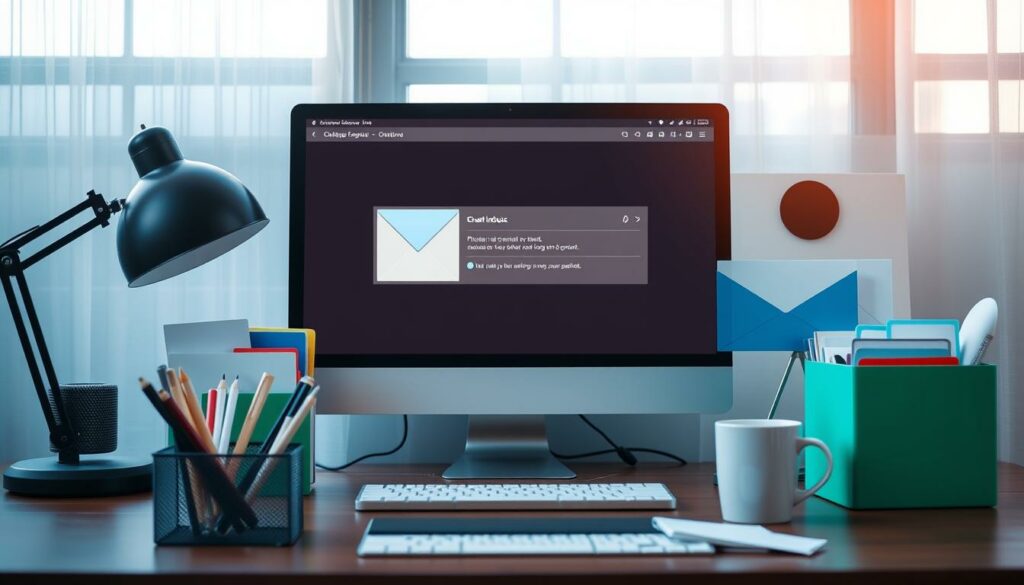Tips To Consolidate Email Accounts for Greater Efficiency
Are you tired of managing many email accounts? It’s time to simplify your digital life by merging them. This can make you more productive and save you time.
Did you know most people handle at least two email accounts? Some even manage three or four. This can really slow you down. But, there’s a way to fix this.
Merging your email accounts into one can change everything. It makes managing passwords easier, boosts security, and keeps your brand consistent. Plus, it can save you money by cutting down on the need for multiple services.
Ready to take charge of your inbox? Let’s look at how to merge your email accounts the right way. With the right tools and strategies, you’ll soon have a more organized digital space.
Importance of Consolidating Email Accounts
In today’s digital world, most people have many email accounts. This can cause missed messages and lower efficiency. To solve these problems, many are choosing email consolidation. By merging email accounts, you can make your communication smoother and increase your productivity.
A unified inbox combines all your email accounts into one spot. This makes it simpler to keep track of all your messages without missing important ones. Tools like Spike offers a simple, chat-like interface that focuses on key communication elements. This can greatly enhance your email management and workflow.
Centralizing email management reduces the time spent switching between accounts. This decrease in email overload lets you focus on what’s truly important. You can set up filters and folders to organize your emails better and keep from feeling overwhelmed by messages.
Choosing to combine email accounts boosts your productivity. With all your emails in one spot, you can respond faster and more efficiently. Some email consolidation tools also offer features like collaborative notes, calendars, and group chats. These extras can turn your email platform into a complete digital workspace, increasing your productivity even more.
How To Consolidate Your Email Accounts: Step-by-Step Guide
Managing multiple email accounts doesn’t have to be overwhelming. By consolidating them into a unified system, you can streamline communication, reduce distractions, and improve efficiency.
Whether you’re looking to merge work and personal emails or simply want to cut down on inbox clutter, the right tools and strategies will help you stay organized.
Follow these steps to integrate your email accounts seamlessly and take back control of your inbox.
1. Identify & Categorize Your Accounts
In 2024, many people have several email accounts for work, personal use, and other needs. To manage them well, it’s important to sort and categorize your accounts.
First, make a list of all your email accounts. This includes work emails, personal ones, and any for specific projects. Some people use different emails for different parts of their life. This can help keep things organized but might also lead to too many emails.
Then, sort your accounts by their main use. This is key when you want to combine email services. Use different accounts for different areas of your life. For example, keep work emails separate from personal ones to keep things clear.
When you combine email services, make sure you don’t lose important contacts. Make a list of key contacts for each account. This helps keep relationships strong and makes communication smoother when you’ve merged your accounts. Remember, good email management comes from strategies like setting up notifications and using email rules.
By organizing your email accounts, you lay the groundwork for better email management. This helps you figure out which accounts to merge and which to keep separate. It ensures you can handle your emails more efficiently in the future.
2. Choosing the Right Email Platform
Selecting the right email platform can simplify your digital life and improve how you manage multiple accounts. The best email services offer powerful features like smart organization, seamless integrations, and strong security. Below are some top choices, along with key factors to consider when picking an email client.
Top Email Platforms and Their Strengths
- Microsoft Outlook – Ideal for Microsoft 365 users, offering seamless integration and a 4.5/5 rating.
- Spark – Known for smart inbox management, making it great for handling high email volume (4.5/5 rating).
- Shortwave – Designed for those who miss Google Inbox, providing a streamlined experience (4.0/5 rating).
- Apple Mail – A strong option for Apple users who prioritize privacy and security.
- Mozilla Thunderbird – Best for tech-savvy users who want deep customization.
- Canary Mail – Uses AI for fast replies and intelligent sorting (4.0/5 rating).
- Twobird – Combines email with task management, offering a 3.5/5 rating.
- OnMail – Gives users control over who can send them emails.
Key Features to Look For
When choosing an email client, consider factors like:
- Storage capacity – Ensure the platform can handle your email volume.
- Integration options – Look for compatibility with your calendar, task manager, and other apps.
- Smart filters and search tools – Help you quickly find and organize emails.
Additional Email Services for Specific Needs
- Mailbird – A user-friendly, unified inbox that supports multiple accounts, starting at $2.28/month.
- Front – Designed for teams, with shared inboxes and analytics for better collaboration.
- Loop – Offers a chat-style email experience for a more conversational workflow.
By selecting an email platform that matches your needs, you can stay organized, save time, and manage your emails more efficiently.

3. Setting Up Email Forwarding
Email forwarding makes communication easier and boosts productivity. Studies show it can make you 15% to 25% more efficient. Let’s look at how to set it up for Gmail and Outlook.
Email forwarding lets you send messages from one account to another. It saves time and cuts down on checking multiple inboxes. By combining your emails, you can tackle important tasks faster and reply quicker.
Gmail forwarding is easy. Just sign in, go to Settings, and click on “Forwarding and POP/IMAP.” Add your new email address and follow the steps to verify it. For Outlook, go to your account settings, pick “Mail,” and then “Forwarding.” Type in the email you want your messages sent to.
After setting up forwarding, managing your settings is key. Check and update your forwarding rules often to ensure messages get to the right place. This can cut down on delivery errors by up to 20%. But, be careful not to create forwarding loops. They can mess up communication and make you 30% less efficient.

4. Using Email Aggregators
Email aggregation tools have changed the game for managing multiple email accounts. They bring all your emails into one spot. This makes it easier to keep track of your inbox.
An email aggregator is a tool that puts messages from different accounts together in one place. It helps you not miss important emails. It also saves time by not needing to switch accounts manually.
Shift is a popular tool that works with many email services like Gmail and Yahoo! Mail. For PC users, apps like Windows Mail or Outlook do the same thing. Mac users can use Apple Mail or Microsoft Outlook for Mac to merge accounts through IMAP settings.
Email aggregators make managing emails more efficient. They offer features like a unified inbox and customizable views. But, there are risks to security and a learning curve with new software.
Some free tools like Zapier Digest and Automate.io let you link multiple apps. This increases convenience but might have limits on storage or syncing.

5. Reduce Spam & Junk Mail
Managing spam is key when you merge email accounts. Most email services have built-in spam filters. But, you might need to tweak them for better results. Gmail, for example, uses Bayesian filtering to spot spam emails.
To boost your email filters, make whitelists for trusted senders and blacklists for spammers. This helps your spam filter work better. Also, report spam emails to your provider to help their algorithms.
It’s important to regularly unsubscribe from emails you don’t want. Tools like Unroll.me and Leave Me Alone help you do this easily. They let you unsubscribe from many emails at once.
For extra protection against spam and phishing, use third-party tools. They add security and help manage spam better. By following these steps, you can keep your inbox clean and efficient.
Staying Secure With Consolidated Accounts
When merging multiple email accounts, security should be a top priority. Protecting your personal information and keeping cyber threats at bay requires strong security measures. Here are key steps to safeguard your accounts:
- Use Strong, Unique Passwords: Avoid common phrases or easily guessed information. A strong password should include:
- A mix of uppercase and lowercase letters
- Numbers and special characters
- At least 12–16 characters in length
- Consider a Password Manager: Managing multiple passwords can be difficult. A password manager helps generate, store, and autofill complex passwords securely, reducing the risk of using weak or repeated passwords.
- Enable Two-Factor Authentication (2FA): 2FA adds an extra layer of protection by requiring a second form of verification—such as a code sent to your phone. This includes your password. Enable this feature on all email accounts for enhanced security.
- Regularly Update Your Passwords: Change your passwords every few months to minimize security risks. Set calendar reminders to ensure you stay proactive.
- Avoid Reusing Passwords: Each account should have a unique password. Reusing passwords across multiple accounts increases vulnerability in case of a data breach.
By following these best practices, you’ll create a solid security foundation for your consolidated email accounts. Remember, you must regularly check and update your email security to stay protected.
Maintaining Email Organization
Keeping your inbox tidy is key in today’s digital world. With over 293 billion emails sent daily, and professionals getting 120 emails a day, it’s vital to stay organized. Let’s look at some ways to clean up your inbox and archive emails to boost your productivity.
Make time for cleaning your inbox. Experts say to check emails three times a day at set times. This helps you stay focused, as it takes about 23 minutes to get back on track after a distraction. Use tools like Clean Email or Unroll.me to make unsubscribing easier and keep your inbox tidy.
Archiving old emails helps keep your inbox manageable while still keeping access to important messages. Gmail, with over 1 billion active users, has great archiving tools. You can zip files to save space and store big attachments easily. Set up auto-clean rules to archive emails based on age or other criteria.
Use your email client’s search features to your advantage. Advanced search lets you find specific messages across different accounts quickly. Tools like Shift and HubSpot Sales offer powerful search options, saving you time. By mastering these search tools, you can manage your emails better and focus on more important tasks.
Tips for Better Email Management
Managing your email well can really help you get more done. In the US, people spend about 28% of their work time on emails. They check their emails around 11 times an hour. To stay on top of this, it’s smart to use some email tips.
Let’s look at ways to make your inbox better and work more efficiently.
Sorting your emails is crucial. Use the “one-minute rule” to quickly handle simple tasks. For longer emails, set aside specific times in your calendar. This way, you can focus on key messages without interruptions. Good email management can also reduce stress and make you more productive.
Connecting your email with your calendar is a big help. It lets you schedule tasks and meetings right from your inbox. This makes it easier to stay organized and ensures you meet deadlines and attend meetings on time.
There are many tools to make your email better. Auto-filters, labels, and colors can save you time and make things more efficient. Some tools even automate replies to common questions. Sharing big video files through cloud storage can also clear up your inbox.
By using these tips and tools, you can take back control of your inbox. Remember, managing your email well is a continuous effort. It needs regular checks and changes to fit your needs.
Final Thoughts: Take Control of Your Inbox Today With DivShare
Consolidating your email accounts is a game-changer for productivity, security, and digital organization. By unifying your inbox and leveraging smart email tools, you’ll reduce clutter and save time. Maintaining a structured system will help you stay on top of important messages effortlessly.
But managing emails is just one part of streamlining your digital workflow. If you deal with large files, and media content, or need secure cloud storage, DivShare can help.
DivShare is a reliable media hosting solution that makes it easy to store, share, and manage your files seamlessly. This allows you to focus on what truly matters.
Sign up for DivShare today and take control of both your inbox and your media management in one efficient move.